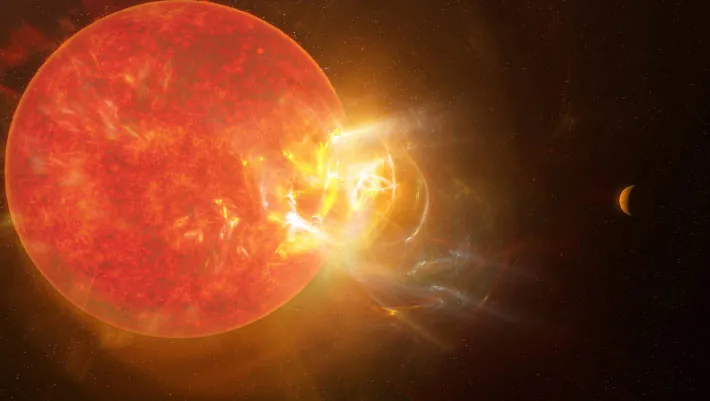
Proxima Centauri's Flaring Frenzy Revealed: Groundbreaking ALMA Observations
2025-03-24
Author: Sarah
Introduction
In a revelation that has taken the astronomical community by storm, new observations from the Atacama Large Millimeter/submillimeter Array (ALMA) have unveiled the extraordinary flaring activity of Proxima Centauri—a red dwarf star located just 4.24 light-years away in the constellation Centaurus. Previously recognized for its flares in visible wavelengths, this new data highlights the star's intense behavior at radio and millimeter wavelengths.
Proxima Centauri: The Basics
Discovered in 1915 by Scottish astronomer Robert Innes, Proxima Centauri—also known as Alpha Centauri C—is part of a triple star system, nestled alongside larger companions Alpha Centauri A and B. While its low average luminosity and compact size (about one-eighth the mass of the Sun) make it invisible to the naked eye, its potential astrobiological significance is massive.
The Habitable Zone
Proxima Centauri hosts the Earth-sized exoplanet Proxima b, which lies within its habitable zone—this proximity raises urgent questions about the implications of such severe stellar activity for any atmosphere that may exist on the planet.
Recent Research Findings
Recent research led by astronomers Kiana Burton from the University of Colorado and Meredith MacGregor from Johns Hopkins University has taken a closer look at Proxima Centauri’s millimeter-wavelength flare activity using both historical data and new ALMA observations. Given that red dwarfs like Proxima behave quite differently than our Sun—primarily due to their internal structure being entirely convective—the level of stellar activity is significantly heightened.
Flares and Their Impact
As Proxima Centauri's magnetic fields twist and snap, they release powerful flares of energy and particles, far exceeding our Sun's surface activity. Dr. MacGregor cautions, “While our Sun produces dazzling auroras without stripping our atmosphere away, the far more potent flares from Proxima Centauri pose a risk to any atmospheres on surrounding rocky planets. Are these flares altering their atmospheres chemically or stripping them entirely?”
The Study's Highlights
This innovative study stands out as the first to investigate Proxima Centauri's flaring through multiple wavelengths, revealing 463 detectable flare events, each ranging in energy from 10²⁴ to 10²⁷ ergs, lasting anywhere from 3 to 16 seconds. Unlike the behavior observed at optical wavelengths, the millimeter-wavelength observations depicted a unique distribution pattern, prompting researchers to recognize that Proxima Centauri experiences flares much more frequently than previously thought.
Insights into Flares
These findings shed light on the asymmetrical nature of the most energetic flares, with their decay phases significantly prolonged compared to their initial bursts. This differentiation is crucial, as it leads to better insights into the energies and particles released by the star during these events.
Conclusion and Future Research
Dr. MacGregor remarked, “The insights gleaned from ALMA’s observations are unique—they’re revealing a whole new realm of flare physics. Without these measurements, critical information concerning the star's activity could slip through the cracks.”
Given the flaring intensity, scientists are left pondering the consequences for Proxima b's potential atmosphere and habitability, kicking off a wave of intrigue and investigation into what life might look like orbiting a star characterized by extreme flaring conditions.
The findings have been documented in the latest edition of the Astrophysical Journal, illuminating a fresh avenue of research that could redefine our approach to studying exoplanets around red dwarfs.
As astronomical technology advances and observation methods improve, this unprecedented study opens the door to further explorations of how dynamic stellar activity shapes the environments of nearby exoplanets. Will Proxima b's habitability withstand the storm? Only time—and more research—will tell!




 Brasil (PT)
Brasil (PT)
 Canada (EN)
Canada (EN)
 Chile (ES)
Chile (ES)
 Česko (CS)
Česko (CS)
 대한민국 (KO)
대한민국 (KO)
 España (ES)
España (ES)
 France (FR)
France (FR)
 Hong Kong (EN)
Hong Kong (EN)
 Italia (IT)
Italia (IT)
 日本 (JA)
日本 (JA)
 Magyarország (HU)
Magyarország (HU)
 Norge (NO)
Norge (NO)
 Polska (PL)
Polska (PL)
 Schweiz (DE)
Schweiz (DE)
 Singapore (EN)
Singapore (EN)
 Sverige (SV)
Sverige (SV)
 Suomi (FI)
Suomi (FI)
 Türkiye (TR)
Türkiye (TR)
 الإمارات العربية المتحدة (AR)
الإمارات العربية المتحدة (AR)